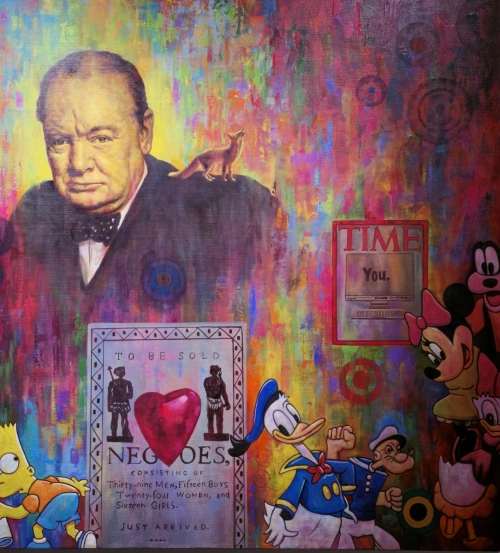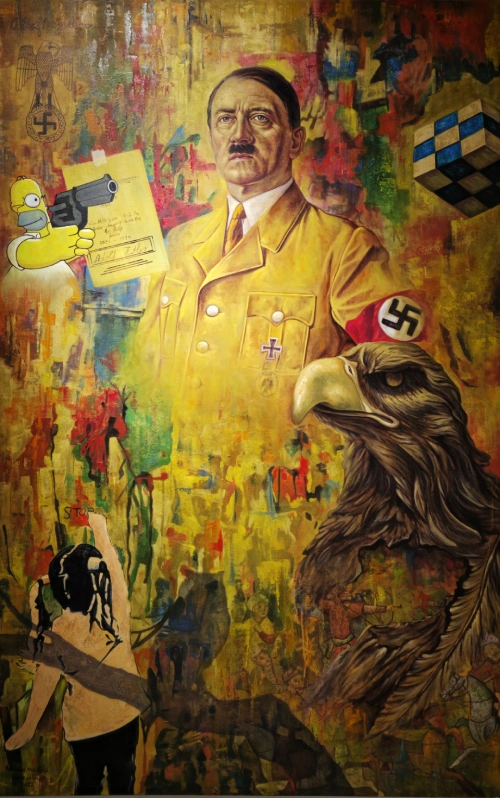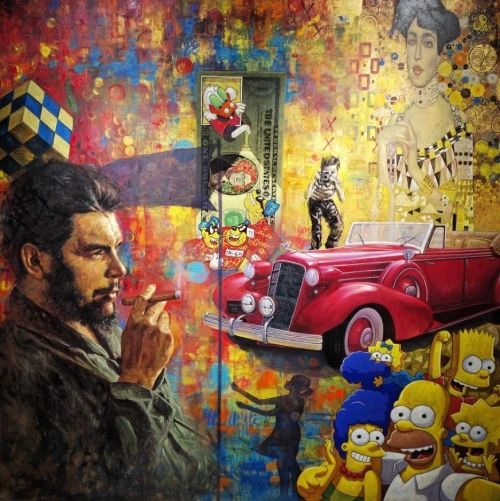Alireza Mousavi-Playful Interplays with War and Death
A Review of the Exhibition "“Tir Rokh” by Alireza Mousavi at Sohum Gallery
Alireza Mousavi[1], a young artist known for his vibrant and luminous use of colour, presents his latest collection titled “Tir Rokh” (Arrow Face). In this series, Mousavi employs iconic historical figures to convey his conceptual themes, ranging from the greatest stars of the art world to powerful figures in war and politics. The collection features personalities such as Marilyn Monroe, Queen Elizabeth, Adolf Hitler, Winston Churchill, and Che Guevara. Additionally, the artist incorporates symbols and elements like The Simpsons animation, the dollar bill, and the Rubik’s Cube to construct the narrative and spatial dynamics of his paintings.
The Superhero Concept and The Simpsons’ Influence
Mousavi has spent the past three years conceptualizing and executing this collection. He revealed that the idea of the superhero has long occupied his mind, and the concept of heroism—both on a global scale and in personal life—has significantly influenced the formation of this body of work. Through this project, he has concluded that each individual’s hero is themselves. In essence, what one sees in the mirror is the hero of their own life. (fig. 1) From the artist’s perspective, superheroes are predetermined, which led him to incorporate The Simpsons into his work. This animation has been analysed and semantically examined for its predictive qualities regarding global events, leading Mousavi to the realization that heroes are artificially constructed and pre-selected. [2]
Exhibition Statement by Siamak Azmi
The exhibition statement, written by Siamak Azmi[3], highlights the artist’s mastery of brushwork and his ability to critique contemporary human concepts and the hollow hero-making processes throughout history. The statement underscores the satirical critique embedded within the cartoonish characters, offering a playful yet profound commentary on these themes.
The artist has chosen variable dimensions for his works, ranging from two meters to forty-five centimetres, with each piece’s size determined by its content and compositional requirements. Mousavi has stated that one of the criteria for selecting the figures in this collection was the manner of their deaths, drawing a connection between arrows, suicide, execution, death, and the title of the series. Alongside these themes, war and economics are also central concerns in his work. [4]
Variable Dimensions and Thematic Elements
The paintings in the collection are intentionally left untitled. The artist believes that the imagery within the frame suffices to convey his ideas and inner thoughts, avoiding redundant verbal explanations. Upon closer inspection, viewers can observe a wide spectrum of colours in the artist’s brushstrokes, which create a play of light and shadow, adding depth and dimension to the works. The role of shadows in this collection is equally significant. In some works, a girl holding a balloon appears in the shadows, while in others, an owl perches on a tree branch in the darkness. These monochromatic and shadowy sections, when viewed up close, reveal intricate layers of blended colours.
Symbolic Imagery and Historical References
In one of the paintings, a girl is seen raising a flag behind Che Guevara, evoking the memory of his defeat in battle. The act of raising the flag in the darkness conjures the imagery of Guevara’s noose and the shadow of his death, despite his execution by firing squad, which ties back to the title of the series. Guevara is positioned in front of a red car, symbolizing capitalism and American hegemony. Above this scene, on the right side of the painting, is a reference to Gustav Klimt’s Portrait of Adele Bloch-Bauer I (The Golden Lady), a painting famously looted by the Nazis during World War II (1933–1941) [5]. These elements serve as clues, like pieces of a puzzle that the artist lays out for the audience to interpret his inner world. On the red car within the painting, a boy is seen capturing the scene with a camera, mirroring the position of The Simpsons characters in the foreground, who are taking a selfie. This interplay of foreground and background captures a moment in time, much like the act of framing a painting.

Fig1: Alireza Mousavi, Untitled, from Tir Rokh collection, oil on canvas.

Fig 2: Alireza Mousavi, Untitled, from Tir Rokh collection, oil on canvas

Fig 3: Alireza Mousavi, Untitled, from Tir Rokh collection, oil on canva
References:
1. Alireza Mosavi
2. Mosavi, Alireza, interview with Firoozeh Saboori, 7 February 2025.
3. Siamak azmi (1972 Iran)
5. Lecleir, Laurai, ‘Stolen Art and Cultural Treasures: An Example from World War II’, Anishinabek News, 9 December 2015